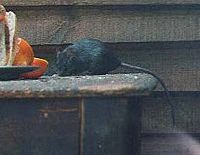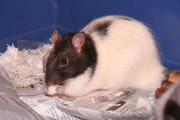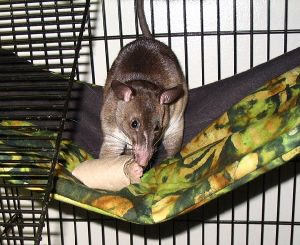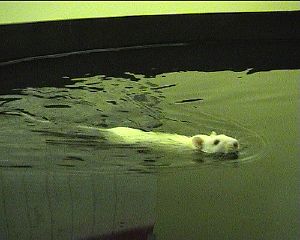Difference between revisions of "Rat" - New World Encyclopedia
(rat laughter fairly trivial) |
|||
| Line 27: | Line 27: | ||
Like most smaller rodents, true rats and most other rats mature rapidly and only live for a short time. The black rat reaches sexual maturity in 80 days; its longest recorded life was 4 years and 2 months (Nowak 1986). Most rat species breed several times each year and have multiple offspring. This lets their populations rapidly expand to take advantage of changes in their environments and also replaces individuals lost to predators. | Like most smaller rodents, true rats and most other rats mature rapidly and only live for a short time. The black rat reaches sexual maturity in 80 days; its longest recorded life was 4 years and 2 months (Nowak 1986). Most rat species breed several times each year and have multiple offspring. This lets their populations rapidly expand to take advantage of changes in their environments and also replaces individuals lost to predators. | ||
| − | + | [[Image:Dipodomys ordii.jpg|thumb|left|Ord's kangaroo rat, ''Dipodomys ordii'']] | |
Most rats are [[omnivore]]s, eating both [[plant]] and [[animal]] foods, and generalists, not bound to one specialized way of life. Among the exceptions to this are the mole rats of [[Africa]] (Bathyergidae family), especially the naked mole rat (''Heterocephalus glaber''), which are highy specialized and live almost their entire lives underground eating [[bulb]]s, [[root]]s, and [[tuber]]s. The fish-eating rats of [[South America]] (''Ichthyomys species'') swim in streams to catch small fish. Kangaroo rats of [[North America]] (''Dipodomys species'') live in [[desert]] evironments and do not need to drink; they get the water they need from the seeds and insects they eat. The marmoset rat of Southeast Asia (''Hapalomys longicaudatus'') feeds mainly on bamboo and builds its nests in the bamboo stems (Nowak 1986). | Most rats are [[omnivore]]s, eating both [[plant]] and [[animal]] foods, and generalists, not bound to one specialized way of life. Among the exceptions to this are the mole rats of [[Africa]] (Bathyergidae family), especially the naked mole rat (''Heterocephalus glaber''), which are highy specialized and live almost their entire lives underground eating [[bulb]]s, [[root]]s, and [[tuber]]s. The fish-eating rats of [[South America]] (''Ichthyomys species'') swim in streams to catch small fish. Kangaroo rats of [[North America]] (''Dipodomys species'') live in [[desert]] evironments and do not need to drink; they get the water they need from the seeds and insects they eat. The marmoset rat of Southeast Asia (''Hapalomys longicaudatus'') feeds mainly on bamboo and builds its nests in the bamboo stems (Nowak 1986). | ||
| Line 37: | Line 37: | ||
==Rats as pests== | ==Rats as pests== | ||
| − | + | [[Image:Rattus norvegicus 1.jpg|thumb|Brown Rat, ''Rattus norvegicus'']] | |
Some species of rats, both true rats and rats of other genera, have become very successful by taking advantage of human activities. The black rat, which is naturally a tree dwelling species, found nesting places and food in barns, houses, and other buildings and spread around the world with the the unwitting help of humans. It is also known as the roof rat and the ship rat. The brown rat, also known as the Norway rat and the sewer rat, is a ground dweller and naturally digs its burrows near water. It gradually spread out of Asia and reached Europe in the 1700s and North and South America soon after. Brown rats mostly live low to the ground, sometimes in city sewers. In some buildings brown rats live in the basement and black rats in the attic (Barnett 2001). Other rat species which have come to live in close association with humans include the rice field rat (''Rattus argentiventer'') of Southeast Asia, the Polynesian rat (''R. exulans'') native to Southeast Asia and spread to the Pacific islands along with humans, the banicoot rats of India and Southeast Asia (''Bandicota bengalensis'', ''B. indica'', and ''B. savilei''), and the pest rat (''Nesokia indica'') which is found from Egypt to China (Nowak 1986). | Some species of rats, both true rats and rats of other genera, have become very successful by taking advantage of human activities. The black rat, which is naturally a tree dwelling species, found nesting places and food in barns, houses, and other buildings and spread around the world with the the unwitting help of humans. It is also known as the roof rat and the ship rat. The brown rat, also known as the Norway rat and the sewer rat, is a ground dweller and naturally digs its burrows near water. It gradually spread out of Asia and reached Europe in the 1700s and North and South America soon after. Brown rats mostly live low to the ground, sometimes in city sewers. In some buildings brown rats live in the basement and black rats in the attic (Barnett 2001). Other rat species which have come to live in close association with humans include the rice field rat (''Rattus argentiventer'') of Southeast Asia, the Polynesian rat (''R. exulans'') native to Southeast Asia and spread to the Pacific islands along with humans, the banicoot rats of India and Southeast Asia (''Bandicota bengalensis'', ''B. indica'', and ''B. savilei''), and the pest rat (''Nesokia indica'') which is found from Egypt to China (Nowak 1986). | ||
These ''[[symbiosis|commensal]]'' (which means "sharing the same table") rat species do a tremendous amount of damage to human interests, mainly by eating crops and stored food and by spreading diseases. It is estimated that rats and mice consume one fifth of the food crops which humans grow each year, including 50 million tons of rice (Voelker 1986). | These ''[[symbiosis|commensal]]'' (which means "sharing the same table") rat species do a tremendous amount of damage to human interests, mainly by eating crops and stored food and by spreading diseases. It is estimated that rats and mice consume one fifth of the food crops which humans grow each year, including 50 million tons of rice (Voelker 1986). | ||
| − | + | [[Image:Jack Black.jpg|left|thumb|English ratcatcher, 1851]] | |
Rats can carry over thirty different [[disease]]s dangerous to humans, including Weil's disease, typhus, salmonella and bubonic plague. Bubonic plague is caused by the [[bacteria]] ''Yersinia pestis'' and spread through the bite of the [[flea]] ''Xenopsylla cheopis''. The plague bacteria and the fleas are common on wild rodents and often seem to do them no harm. When the disease spreads to commensal rats, especially the black rat, humans can be infected. In the [[Middle Ages]] bubonic plague outbreaks were common in European cities and sometimes killed 25 percent or more of the population. In the early Twentieth Century plague killed around a million people a year in India and continues to be a problem today (Barnett 2001). | Rats can carry over thirty different [[disease]]s dangerous to humans, including Weil's disease, typhus, salmonella and bubonic plague. Bubonic plague is caused by the [[bacteria]] ''Yersinia pestis'' and spread through the bite of the [[flea]] ''Xenopsylla cheopis''. The plague bacteria and the fleas are common on wild rodents and often seem to do them no harm. When the disease spreads to commensal rats, especially the black rat, humans can be infected. In the [[Middle Ages]] bubonic plague outbreaks were common in European cities and sometimes killed 25 percent or more of the population. In the early Twentieth Century plague killed around a million people a year in India and continues to be a problem today (Barnett 2001). | ||
| Line 49: | Line 49: | ||
==Domesticated rats== | ==Domesticated rats== | ||
| + | [[Image:Cloudtherat1.jpg|thumb|Pet brown rat.]] | ||
| + | [[Image:Cricetomys emini.jpg|thumb|Pet pouched rat, ''Cricetomys emini'']] | ||
| + | The domestication of rats started in [[England]] with the sport of rat-baiting in which rats were put into a pit and killed by dogs. Captive rats were breed to provide a constant supply of victims. From time to time a white or spotted rat would be born because of genetic [[mutation]]. These were breed with each other and proved to be popular as pets. | ||
| + | The giant pouched rat of Africa (''Cricetomys emini'') is also sometimes kept as a pet. | ||
| + | [[Image:RatBaiting2.jpg|thumb|left|Rat-baiting pit]] | ||
| + | [[Image:MorrisWaterMaze.jpg|thumb|left|Laboratory rat in water maze experiment]] | ||
| + | |||
| + | |||
==The Rat== | ==The Rat== | ||
The best-known rat species are the [[Black Rat]] ''Rattus rattus'' and the [[Brown Rat]] ''R. norvegicus''. There is also one type of rat called ''Tars'', usually found on [[Mount Everest]]. The group is generally known as the Old World rats or true rats, and originated in [[Asia]]. Rats are bigger than most of their relatives, the Old World [[mouse|mice]], but seldom weigh over 500 [[gram]]s (1 [[Pound (mass)|lb]]) in the wild. The common term "rat" is also used in the names of other small [[mammal]]s which are not true rats. Examples include the [[North America]]n [[pack rat]]s, a number of species loosely called [[kangaroo rat]]s, and a number of others. Other rats such as the [[Bandicoot rat]] ''Bandicota bengalensis'' are murine rodents related to the true rats, but are not members of the genus ''Rattus''. The widely distributed and problematic commensal species of rats represent a minority in this diverse genus. Many species of rats are [[Endemic (ecology)|island endemic]]s and some have become endangered due to habitat loss or competition with [[brown rat|brown]], [[Black Rat|black]], or [[Polynesian Rat|Polynesian]] rats. | The best-known rat species are the [[Black Rat]] ''Rattus rattus'' and the [[Brown Rat]] ''R. norvegicus''. There is also one type of rat called ''Tars'', usually found on [[Mount Everest]]. The group is generally known as the Old World rats or true rats, and originated in [[Asia]]. Rats are bigger than most of their relatives, the Old World [[mouse|mice]], but seldom weigh over 500 [[gram]]s (1 [[Pound (mass)|lb]]) in the wild. The common term "rat" is also used in the names of other small [[mammal]]s which are not true rats. Examples include the [[North America]]n [[pack rat]]s, a number of species loosely called [[kangaroo rat]]s, and a number of others. Other rats such as the [[Bandicoot rat]] ''Bandicota bengalensis'' are murine rodents related to the true rats, but are not members of the genus ''Rattus''. The widely distributed and problematic commensal species of rats represent a minority in this diverse genus. Many species of rats are [[Endemic (ecology)|island endemic]]s and some have become endangered due to habitat loss or competition with [[brown rat|brown]], [[Black Rat|black]], or [[Polynesian Rat|Polynesian]] rats. | ||
| Line 57: | Line 65: | ||
Rats have a normal lifespan ranging from two to five years, though three years is typical. | Rats have a normal lifespan ranging from two to five years, though three years is typical. | ||
| − | |||
| − | |||
| − | |||
=== Eastern cultures === | === Eastern cultures === | ||
| Line 93: | Line 98: | ||
Rats, particularly roof rats (''Rattus rattus''), can enter the attics of homes where they mate and nest. This problem occurs commonly in coastal, temperate climates and affects even the cleanest, well-kept homes. | Rats, particularly roof rats (''Rattus rattus''), can enter the attics of homes where they mate and nest. This problem occurs commonly in coastal, temperate climates and affects even the cleanest, well-kept homes. | ||
| − | + | ||
| − | |||
| − | |||
==References== | ==References== | ||
| Line 103: | Line 106: | ||
* Nowak, R. M., and J. L. Paradiso. 1983. ''Walker's Mammals of the World''. Baltimore, Maryland: The Johns Hopkins University Press. ISBN 0801825253. | * Nowak, R. M., and J. L. Paradiso. 1983. ''Walker's Mammals of the World''. Baltimore, Maryland: The Johns Hopkins University Press. ISBN 0801825253. | ||
* Voelker, W. 1986. ''The Natural History of Living Mammals''. Medford, New Jersey: Plexus Publishing, Inc. ISBN 0937548081. | * Voelker, W. 1986. ''The Natural History of Living Mammals''. Medford, New Jersey: Plexus Publishing, Inc. ISBN 0937548081. | ||
| − | |||
| − | |||
| − | |||
| − | |||
| − | |||
| − | |||
| − | |||
| − | |||
| − | |||
| − | |||
| − | |||
| − | |||
| − | |||
| − | |||
| − | |||
| − | |||
| − | |||
| − | |||
[[Category:Life sciences]] | [[Category:Life sciences]] | ||
{{credit|104753593}} | {{credit|104753593}} | ||
Revision as of 21:54, 17 March 2007
| Rats
| ||||||||||||||||
|---|---|---|---|---|---|---|---|---|---|---|---|---|---|---|---|---|
 Black Rat (Rattus rattus)
| ||||||||||||||||
| Scientific classification | ||||||||||||||||
| ||||||||||||||||
|
50 species; see text |
Rats are various medium sized rodents. "True rats" are members of the genus Rattus, the most important of which to humans are the black rat, Rattus rattus, and the brown rat, R. norvegicus. Many members of other rodent genera and families are also called rats and share many characteristics with true rats.
Rats are distinguished from mice by their size; rats generally have bodies longer than 12 cm (5 inches). Squirrels of most species are about the same size as rats but are members of their own family, Sciuridae, and are usually more specialized than rats.
General rat characteristics
Like most smaller rodents, true rats and most other rats mature rapidly and only live for a short time. The black rat reaches sexual maturity in 80 days; its longest recorded life was 4 years and 2 months (Nowak 1986). Most rat species breed several times each year and have multiple offspring. This lets their populations rapidly expand to take advantage of changes in their environments and also replaces individuals lost to predators.
Most rats are omnivores, eating both plant and animal foods, and generalists, not bound to one specialized way of life. Among the exceptions to this are the mole rats of Africa (Bathyergidae family), especially the naked mole rat (Heterocephalus glaber), which are highy specialized and live almost their entire lives underground eating bulbs, roots, and tubers. The fish-eating rats of South America (Ichthyomys species) swim in streams to catch small fish. Kangaroo rats of North America (Dipodomys species) live in desert evironments and do not need to drink; they get the water they need from the seeds and insects they eat. The marmoset rat of Southeast Asia (Hapalomys longicaudatus) feeds mainly on bamboo and builds its nests in the bamboo stems (Nowak 1986).
The genus Rattus
The genus Rattus, true rats, is one of the largest genera of mammals including as many as 78 species (Nowak 1986). True rats are native to Southeast Asia, Australia, and the nearby islands. Some species build nests in trees while other burrow into the ground. Most live in groups ranging from a few individuals to one hundred or more. Rats fight to establish dominance within the group but rarely kill or injure each other. Sometimes females within a group will nurse each other's young.
True rats are opportunistic feeders, eating seeds, fruit, vegetables, insects, other small animals. Most true rats live in forests or near rivers or other bodies of water. In Australia some species live in grasslands and desert environments.
Rats as pests
Some species of rats, both true rats and rats of other genera, have become very successful by taking advantage of human activities. The black rat, which is naturally a tree dwelling species, found nesting places and food in barns, houses, and other buildings and spread around the world with the the unwitting help of humans. It is also known as the roof rat and the ship rat. The brown rat, also known as the Norway rat and the sewer rat, is a ground dweller and naturally digs its burrows near water. It gradually spread out of Asia and reached Europe in the 1700s and North and South America soon after. Brown rats mostly live low to the ground, sometimes in city sewers. In some buildings brown rats live in the basement and black rats in the attic (Barnett 2001). Other rat species which have come to live in close association with humans include the rice field rat (Rattus argentiventer) of Southeast Asia, the Polynesian rat (R. exulans) native to Southeast Asia and spread to the Pacific islands along with humans, the banicoot rats of India and Southeast Asia (Bandicota bengalensis, B. indica, and B. savilei), and the pest rat (Nesokia indica) which is found from Egypt to China (Nowak 1986).
These commensal (which means "sharing the same table") rat species do a tremendous amount of damage to human interests, mainly by eating crops and stored food and by spreading diseases. It is estimated that rats and mice consume one fifth of the food crops which humans grow each year, including 50 million tons of rice (Voelker 1986).
Rats can carry over thirty different diseases dangerous to humans, including Weil's disease, typhus, salmonella and bubonic plague. Bubonic plague is caused by the bacteria Yersinia pestis and spread through the bite of the flea Xenopsylla cheopis. The plague bacteria and the fleas are common on wild rodents and often seem to do them no harm. When the disease spreads to commensal rats, especially the black rat, humans can be infected. In the Middle Ages bubonic plague outbreaks were common in European cities and sometimes killed 25 percent or more of the population. In the early Twentieth Century plague killed around a million people a year in India and continues to be a problem today (Barnett 2001).
Other damage caused by rats includes damaging dams and irrigation works by burrowing, causing power outages and fire by gnawing electric wires, contaminating food, damaging furniture, and many other things. About 14,000 Americans are bitten by rats every year (Voelker 1986).
A variety of rat control methods have been used throughout human history to either reduce or eliminate rat populations in homes, markets, farms, and industrial sites. The two most widely used methods are poison and traps. Cats and dogs have also been employed to hunt rats. Professional rat-catchers can be found in many developing countries and rat control is a big business world-wide.
Domesticated rats
The domestication of rats started in England with the sport of rat-baiting in which rats were put into a pit and killed by dogs. Captive rats were breed to provide a constant supply of victims. From time to time a white or spotted rat would be born because of genetic mutation. These were breed with each other and proved to be popular as pets. The giant pouched rat of Africa (Cricetomys emini) is also sometimes kept as a pet.
The Rat
The best-known rat species are the Black Rat Rattus rattus and the Brown Rat R. norvegicus. There is also one type of rat called Tars, usually found on Mount Everest. The group is generally known as the Old World rats or true rats, and originated in Asia. Rats are bigger than most of their relatives, the Old World mice, but seldom weigh over 500 grams (1 lb) in the wild. The common term "rat" is also used in the names of other small mammals which are not true rats. Examples include the North American pack rats, a number of species loosely called kangaroo rats, and a number of others. Other rats such as the Bandicoot rat Bandicota bengalensis are murine rodents related to the true rats, but are not members of the genus Rattus. The widely distributed and problematic commensal species of rats represent a minority in this diverse genus. Many species of rats are island endemics and some have become endangered due to habitat loss or competition with brown, black, or Polynesian rats.
In Western countries, many people keep domesticated rats as pets. These are of the species R. norvegicus, which originated in the grasslands of China and spread to Europe and eventually, in 1775, to the New World. Pet rats are Brown Rats descended from those bred for research, and are often called "fancy rats", but they are still the same species as the common city "sewer" rat. Domesticated rats tend to be both more docile than their wild ancestors and more disease prone, presumably due to inbreeding.
The common species are opportunistic survivors and often live with and near humans. The Black Plague is traditionally believed to have been caused by the micro-organism Yersinia pestis, carried by the rat flea Xenopsylla cheopis which preyed on R. rattus living in European cities of the day; it is notable that these rats were victims of the plague themselves. It has recently been suggested that neither rats nor infected fleas would have spread fast enough through Europe to be a likely culprit, although this is controversial and research continues.[citation needed] Regardless, rats are frequently blamed for damaging food supplies and other goods. Their reputation has carried into common parlance: in the English language, "rat" is an insult and "to rat on someone" is to betray them by denouncing to the authorities a crime or misdeed they committed. While modern wild rats can carry Leptospirosis and some other "zoonotic" conditions (those which can be transferred across species, to humans, for example), these conditions are in fact rarely found.[citation needed] Wild rats living in good environments are typically healthy and robust animals. Wild rats living in cities may suffer themselves from poor diet and internal parasites and mites, but do not generally spread disease to humans.
Rats have a normal lifespan ranging from two to five years, though three years is typical.
Eastern cultures
In Imperial Chinese culture, the rat (sometimes referred to as a mouse) is the first of the twelve animals of the Chinese zodiac. People born in this year are expected to possess qualities associated with rats. These include creativity, honesty, generosity, ambition, a quick temper and wastefulness. "Rats" (i.e. people born in a year of the rat) are said to get along well with "monkeys" and "dragons," and to get along poorly with "horses."
In India in the northwestern city of Deshnoke, the Karni Mata Temple, the rats are held to be destined for reincarnation as Sadhus, Hindu holy men. The attending priests feed milk and grain, of which the pilgrims also partake, to the animals. Eating food that has been touched by the animals is considered a blessing from god.
Western cultures
Western associations with the rat are generally negative. For instance, "Rats!" is used as a substitute for various vulgar interjections. These associations do not draw, per se, from any biological or behavioral trait of the rat, but possibly from the association of rats (and fleas) with the 14th-century medieval plague called the Black Death. Rats are seen as vicious, unclean, parasitic animals that steal food and spread disease. However many people in Western cultures keep rats as pets and conversely find them to be tame, clean, intelligent, and playful. While undomesticated rats, dogs, and cats may all be pests in urban areas, in Western countries poisoning rats is commonly accepted, while doing the same to feral dogs and cats would be an unpopular solution in the view of many people.
Describing a person as "rat-like" usually implies he is unattractive and suspicious. In contrast, mice are stereotyped as cute and bourgeois.
Rat is also a term (noun and verb) in criminal (often Mafia) slang for a criminal informant.
Rats are often used in scientific experiments; many animal rights activists allege that treatment of rats in this context is cruel. The term "lab rat" is therefore sometimes used, like guinea pig, to describe a person who is manipulated in a social experiment.
Rats as vermin
By most standards, rats are considered pests or vermin. They can be very destructive to crops and property. Rats can quickly overpopulate when they live in a place where they have no predators, such as in certain cities, and their numbers can become hard to contain. Because of this, the entire province of Alberta, Canada has upheld and maintained a rat-free status since the early 1950s[1]; it is even illegal to keep pet rats there.
Rats have a significant impact on food production. Estimates vary, but it is likely that anything between one-fifth and one-third of the world's total food output is eaten, spoiled or destroyed by rats and other rodents.[2]
Rats can carry over thirty different diseases dangerous to humans, including Weil's disease, typhus, salmonella and bubonic plague. Black rats are suspected to have had a role in the Black Death, an epidemic which killed at least 75 million people in Europe, the Middle East, and Asia in the mid-late 14th century.
A variety of rat control methods have been used throughout human history to either reduce or eliminate rat populations in homes, markets, farms, and industrial sites. The two most widely used methods are rat poison and rat traps, though cats and dogs have also been employed to hunt rats. Professional rat-catchers can be found in many developing countries.
Because rats are nocturnal, daytime sightings of rat activity can mean that their nesting areas have been disturbed or, more likely, that there is overpopulation of them in the local area. [3] It is typically at this point that vermin control measures tend to increase.
Rats often chew electrical cables. Around 26% of all electrical cable breaks are caused by rats, and around 18% of all phone cable breaks. Around 25% of all fires of unknown origin are estimated to be caused by rats.[4]
Rats, particularly roof rats (Rattus rattus), can enter the attics of homes where they mate and nest. This problem occurs commonly in coastal, temperate climates and affects even the cleanest, well-kept homes.
ReferencesISBN links support NWE through referral fees
- Barnett, S. A. 2001. The Story of Rats: Their Impact on Us, and Our Impact on Them. Crows Nest, NSW, Australia : Allen & Unwin. ISBN 1-86508-519-7 .
- IUCN Species Survival Commission (IUCN). 2007. .2007 ICUN Red List of Threatened Species. International Union for Conservation of Nature and Natural Resources. Retrieved March , 2007.
- Invasive Species Specialist Group (ISSG). 2007. Global invasive species database: Rattus rattus. Invasive Species Specialist Group Website. Retrieved March , 2007.
- Nowak, R. M., and J. L. Paradiso. 1983. Walker's Mammals of the World. Baltimore, Maryland: The Johns Hopkins University Press. ISBN 0801825253.
- Voelker, W. 1986. The Natural History of Living Mammals. Medford, New Jersey: Plexus Publishing, Inc. ISBN 0937548081.
Credits
New World Encyclopedia writers and editors rewrote and completed the Wikipedia article in accordance with New World Encyclopedia standards. This article abides by terms of the Creative Commons CC-by-sa 3.0 License (CC-by-sa), which may be used and disseminated with proper attribution. Credit is due under the terms of this license that can reference both the New World Encyclopedia contributors and the selfless volunteer contributors of the Wikimedia Foundation. To cite this article click here for a list of acceptable citing formats.The history of earlier contributions by wikipedians is accessible to researchers here:
The history of this article since it was imported to New World Encyclopedia:
Note: Some restrictions may apply to use of individual images which are separately licensed.





